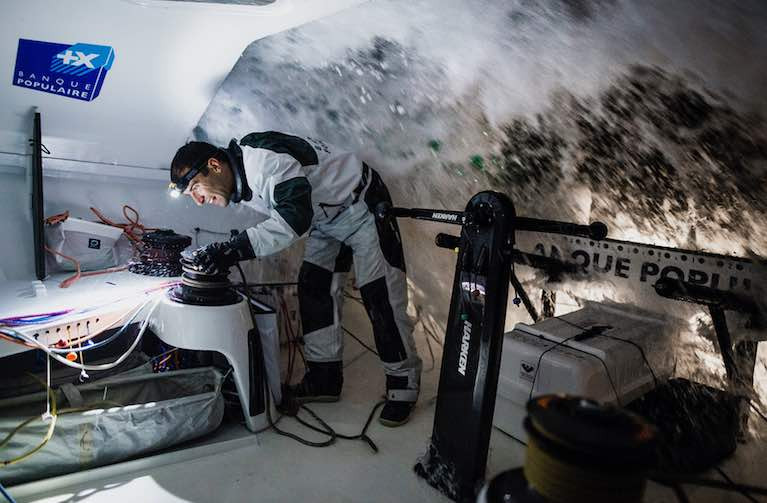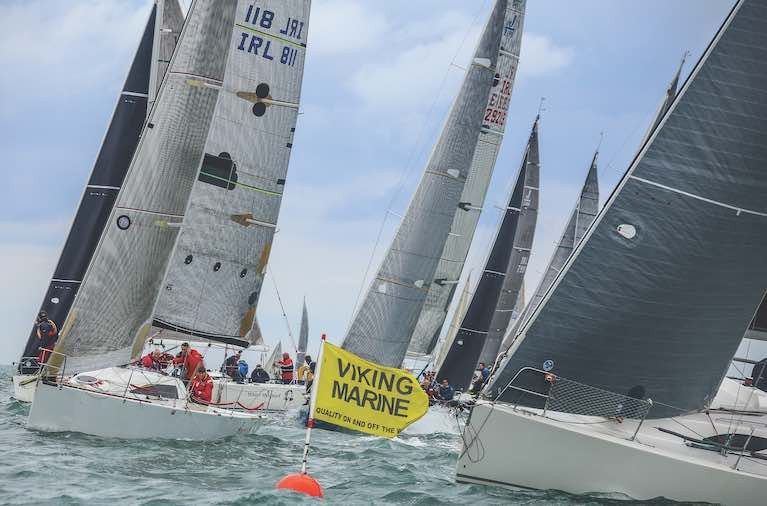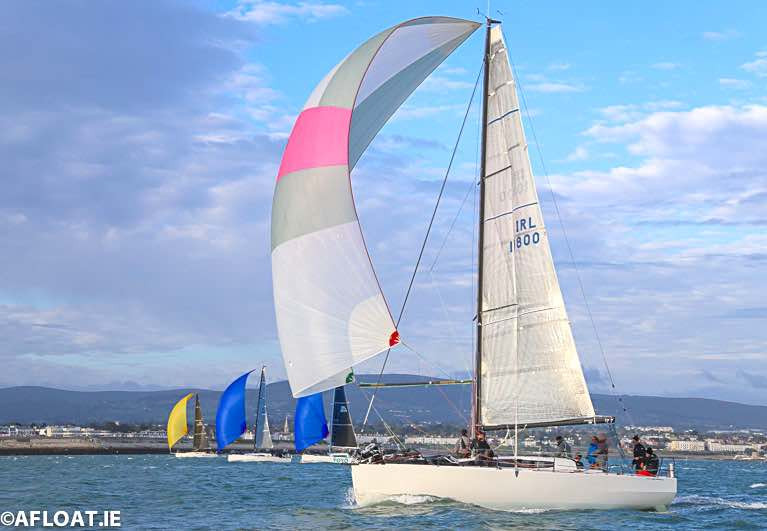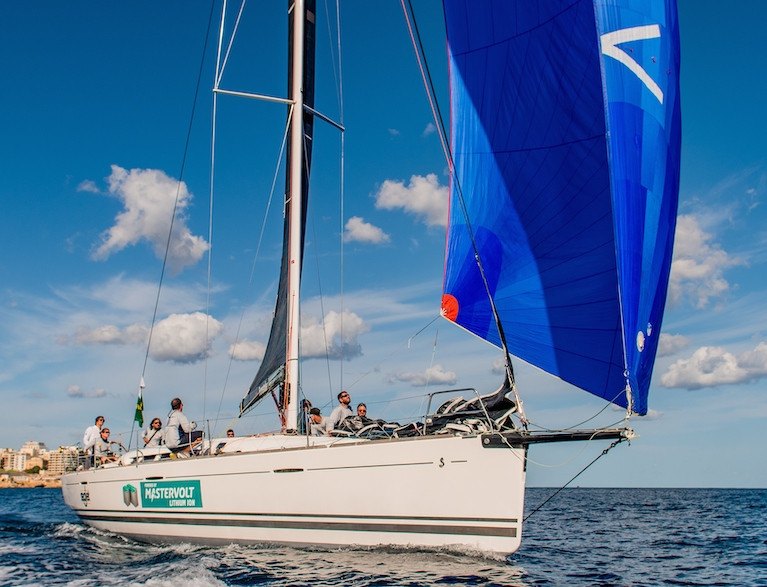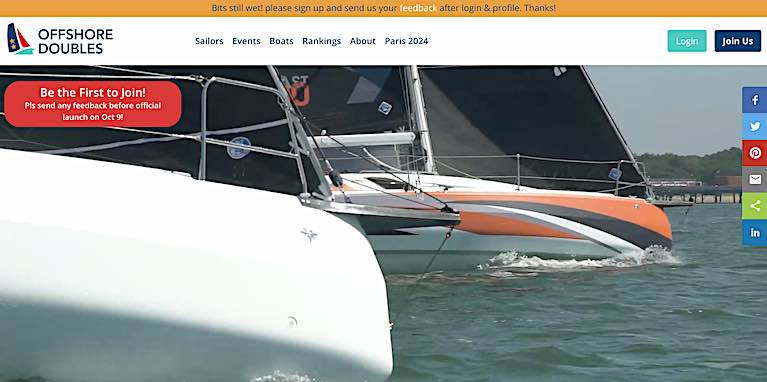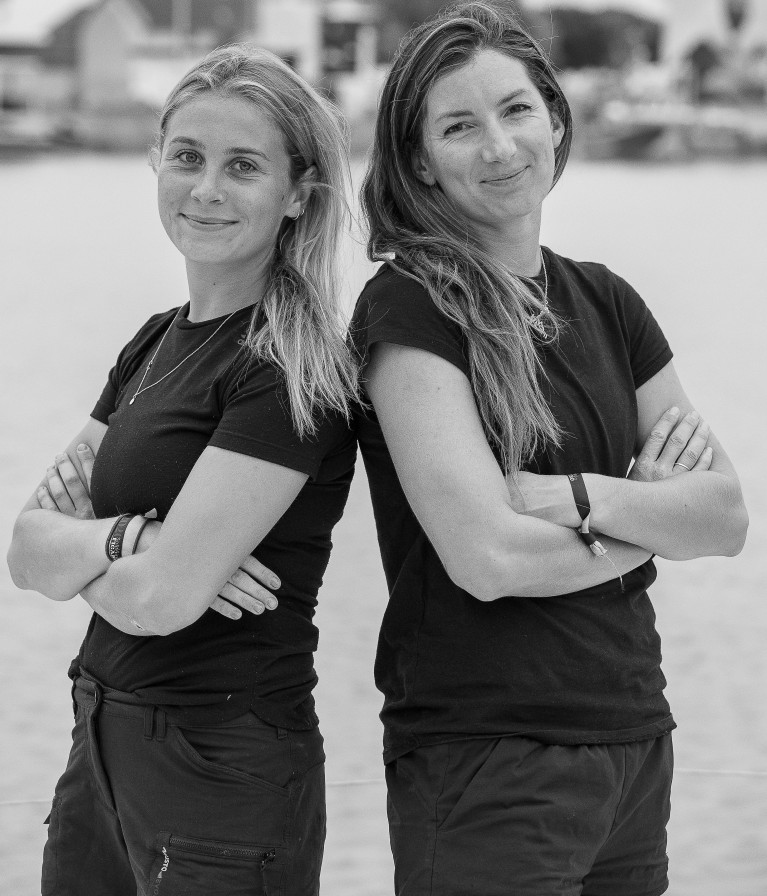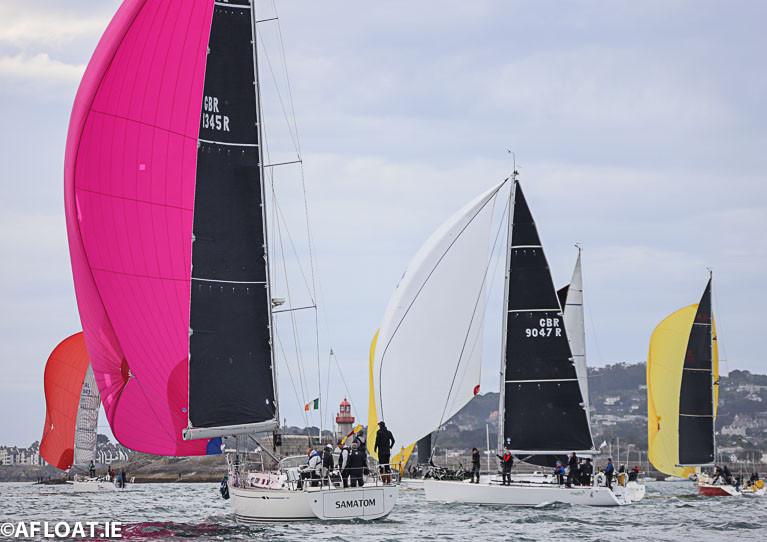Displaying items by tag: Offshore
Peter Ryan Re-elected ISORA Chairman for 2021 Offshore Sailing Season
Peter Ryan, who was first elected to chair ISORA in 2007, will lead the Irish Sea offshore sailing body into the 2021 season following his reelection as chairman at November's virtual ISORA AGM hosted by Pwhelli Sailing Club.
Ryan, of the National Yacht Club in Dun Laoghaire Harbour, is the only Irish Flag Officer in an otherwise Welsh-based executive with Vice Chairman Peter Dunlop and Stephen Tudor remaining as Secretary/Treasurer and Webmaster, both of Pwhelli Sailing Club. The Social Media Secretary is Victoria Cox.
ISORA's General Sailing Committee, that decides on coastal and offshore race courses, also carry the remit of providing guidance and encouragement for other competitors. The 2021 committee includes a number of key competitors including three Royal St. George skippers, Chris Power Smith of J122 Aurelia, Lindsay Casey, skipper of the J97 Windjammer and Brendan Coghlan, from the Sunfast 3600, Yoyo.
 Brendan Coghlan's Sunfast 3600, Yoyo. Photo: Afloat
Brendan Coghlan's Sunfast 3600, Yoyo. Photo: Afloat
Full details of the ISORA Committees are here.
Cape Horners Launch Register of Solo Circumnavigations
As 33 potential Cape Horners prepare for the start of the 9th Vendée Globe solo non-stop round the world race from Les Sables d’Olonne on November 8, The International Association of Cape Horners (IACH) has taken on the mantle of maintaining an official register of those who have completed solo circumnavigations via the Three Great Capes – Good Hope, Leeuwin and the Horn.
The listing, which records 155 solo non-stop circumnavigators and a further 143 who have completed true circumnavigations around the three Capes with stops en route, has been compiled from listings maintained previously by Sir Robin Knox-Johnston, the first to complete a solo non-stop circumnavigation back in 1969, historian DH ‘Nobby’ Clarke, The World Sailing Speed Record Council and information culled from books and the public domain.
Click here to review the IACH Register of Solo Circumnavigators
Commenting on the new Register, Sir Robin said today: "It seems totally appropriate that the IACH now becomes the holder of the list of solo circumnavigators passing south of the Three Great Capes. This is a valuable resource.”
 Jean-Luc Van Den Heede (left) being congratulated by Sir Robin Knox-Johnston after winning the 2018/19 Golden Globe Race. Photo credit: Christophe Favreau/PPL/GGR
Jean-Luc Van Den Heede (left) being congratulated by Sir Robin Knox-Johnston after winning the 2018/19 Golden Globe Race. Photo credit: Christophe Favreau/PPL/GGR
Jean-Luc Van Den Heede, the father figure of French solo sailing and a serial Cape Horner who has rounded the infamous Cape 10 times, the last time when leading the 2018/19 Golden Globe Race, agrees: “To list all the sailors who have turned around the world alone with or without stopovers has been a huge task. It is a very important part of the history of navigation and I hope a lot more names will be added over time.”
 The current record for the fastest solo non-stop circumnavigation is held by Frenchman François Gabart with a time of 42 days 16h 40' 3" set in 2017 aboard the 30m trimaran Ultim MACIF. Photo: Jean-Marie LIOT / ALEA / MACIF
The current record for the fastest solo non-stop circumnavigation is held by Frenchman François Gabart with a time of 42 days 16h 40' 3" set in 2017 aboard the 30m trimaran Ultim MACIF. Photo: Jean-Marie LIOT / ALEA / MACIF
The current record for the fastest solo non-stop circumnavigation is held by Frenchman François Gabart with a time of 42 days 16h 40' 3" set in 2017 aboard the 30m trimaran Ultim MACIF. The time to beat for the current Vendée Globe monohull entrants is 74d 03h 36' set by fellow Frenchman Armel Le Cléac’h in his IMOCA 60 Banque Populaire during the last race in 2017.
The oldest solo circumnavigator is Australian yachtsman Bill Hatfield who, at 79, completed a west-about route in his 11.58m monohull L'Eau Commotion in 2018 with a time of 414 days. The youngest is fellow Australian Jessica Watson who in 2010 at the age of 16, completed a non-stop solo Southern Hemisphere circumnavigation via the three Great Capes in her 10.23m yacht Ella's Pink Lady but failed to sail the full 21,600 orthodromic distance set by the WSSRC to claim a full circumnavigation.
History and membership criteria
All who complete a circumnavigation via Cape Horn are welcome to join the exclusive International Association of Cape Horners and claim an official certificate to commemorate their achievement.
The Amicale Internationale des Capitaines au Long Cours Cap Horniers was founded in 1936 by a group of French Master Mariners based in St Malo to form an exclusive, albeit dying bond, between those who had sailed round Cape Horn in square rigged sailing ships. Those are now history. The last commercial sailing ship voyage was in 1949 when the Pamir and Passat sailed from South Australia bound for Falmouth. In 1969, the British Chapter of the Association became the International Association of Cape Horners (IACH) and amended the membership criteria to read: ‘To promote and strengthen the ties of comradeship which bind together the unique body of men and women who enjoy the distinction of having voyaged round Cape Horn under sail.’
Specifically, full membership, currently £20 per annum, is open to those who have rounded Cape Horn under sail as part of a non-stop passage of at least 3,000 nautical miles which passes above the latitude of 52° South in both the Pacific and Atlantic Oceans and is completed without the use of engines for propulsion.
Associates are those with an interest in Cape Horn but whose experiences do not meet the full membership criteria. One of the latest Associates is Susie Goodall whose yacht was pitch-poled and dismasted 2,000 miles west of Cape Horn during the 2018/19 Golden Globe Race.
This modernising approach has opened membership to all those who have raced around Cape Horn in events like the Whitbread and Volvo Ocean races, Sir Chay Blyth’s Global Challenge events, the Jules Verne Challenge and solo events such as the BOC Challenge, Vendée Globe, Five Oceans and Golden Globe races. Membership is also open to the many who have cruised around the infamous Cape under sail.
“Sailing around Cape Horn, the Everest of ocean sailing, has always been a badge of honour. I commend anyone who has achieved this great feat to join the IACH”, says the Earl of Portsmouth, the Association’s President.
How Will COVID-19 Affect Yacht Racing in 2021?
Four-time Olympic keelboat helmsman Mark Mansfield, a regular competitor at Irish IRC and one-design regattas and Irish agent for some well-known sailing brands, reviews how the 2020 sailing season 'happened' in pandemic and considers what could be done to keep the scene alive in 2021
2020 will likely go down as one of the strangest ever yacht racing seasons. It started back in January with great optimism, looking forward to such events as the Round Ireland Race, The 300th Anniversary Cork Week Regatta, Bangor Regatta on Belfast Lough and Wave Regatta in Howth. In the end, though some regattas were rescheduled for later in the year, all foundered with the ups and downs of the dreaded Covid-19 pandemic.
In the few months from May to August, some reasonable racing was allowed to be had at club level around the country, including a decent number of DBSC races on Dublin Bay and a revamped ISORA series from Dun Laoghaire Harbour.
 Article author Mark Mansfield suggests reduced crew numbers and an emphasis on coastal course racing can help to keep cruiser-racer going in 2021
Article author Mark Mansfield suggests reduced crew numbers and an emphasis on coastal course racing can help to keep cruiser-racer going in 2021
One of the highlights was a pop up offshore fixture, the inaugural 260-mile Fastnet 450 Race, which involved a race from Dun Laoghaire on the East Coast around the Fastnet Rock on the South Coast and into Cork Harbour, all held under strict no contact Covid regulations with an online briefing and prizegiving.
 The winner of the Fastnet 450 Race was Royal Cork yacht Nieulargo (Denis and Annamarie Murphy Photo: Afloat
The winner of the Fastnet 450 Race was Royal Cork yacht Nieulargo (Denis and Annamarie Murphy Photo: Afloat
Clearly, the lessons learned in 2020 will need to be brought into 2021 to see what was successful, and what was not.
Going forward, large onshore events which involve a lot of socialising and shoreside entertainments will not likely be a runner again in 2021. So how should we be preparing to ensure 2021 allows decent racing and allows owners to get good use out of their boats? Here are some suggestions and thoughts on this.
Boat crew numbers
When Afloat published my thoughts on the 12th of May about how keelboat racing work can with social distancing, I suggested that reducing cruiser crew numbers while racing would assist in social distancing and project the right image.
This article was picked up by the international sailing media and carried by websites around the world. I got a lot of positive feedback.
 A screenshot of Mark Mansfield's May article in Afloat setting out how keelboat racing can be kept going in pandemic
A screenshot of Mark Mansfield's May article in Afloat setting out how keelboat racing can be kept going in pandemic
In Ireland, Irish Sailing, the national governing body, decided to effectively open up to full crews on yachts, after initially being ultra-cautious and allowing no cruiser-racing apart from same household crews. Then, when Level 3 came in, all racing was closed down again, despite other sports continuing to compete. This course of action and the zig-zag nature of their direction has led to a lot of disquiet and it continues.
In the UK, when they allowed cruiser racing to open up, it initially was with household crews, then when this was extended it was with limited numbers while racing.
80% of a boats IRC crew number rounded to the nearest whole number was the norm with events such as the RORC IRC National Championships and the J Cup, both held under these restrictions.
I appreciate sailing happens in the open air and it has been rare to find anyone being infected with Covid-19 while sailing, however, reducing crew numbers shows the sport is making the effort and the optics are much better. Eight bodies sitting out shoulder to shoulder on a 35-footer does not give the right impression.
 Before COVID - The successful Dublin Bay J109 Joker II going upwind in Kinsale at the 2017 ICRA Nationals – which she won
Before COVID - The successful Dublin Bay J109 Joker II going upwind in Kinsale at the 2017 ICRA Nationals – which she won
With many owners struggling to fill full crew positions on their boats anyway, restricting all boat crew numbers could also help level the playing field. Maybe Irish Sailing and the Clubs it represents could look at this as an option to allow racing to continue next year?
2021 Irish Sailing Calendar
2021 is scheduled to be another big year if Covid allows it. For cruiser-racers around the country, you have, in addition to DBSC, ISORA and other club racing, the following big events.
- Scottish Series, Tarbert, 28th May to 31 May 2021
- Dun Laoghaire Dingle Race, 9th June
- Sovereign's Cup, Kinsale, 23rd to 26th of June
- Bangor Town Regatta, Belfast Lough, 24th to 27th June
- Volvo Dun Laoghaire Regatta, 8th to 11th July
- Calves Week, Schull, 3rd to 6th of August
- ICRA Nationals, National YC, 3rd to 5th of September
Add to this WIORA in Tralee, and perhaps another Fastnet 450 Race and this could be a really great season—if it all goes ahead. So how does sailing position itself to be able to complete these larger regattas in what will likely still be a Summer of Covid restrictions? The answer has to be:
Good PR – Highlighting the Covid restrictions to make everyone safe—no gatherings, no briefings, no in-person prizegivings. Highlight the sailing, not the shore activities.
Reduce crew numbers – see above
Provide more coastal and longer races – rather than the three races a day that is the norm. Shorter races with more turning marks need more crew aboard and all the crew end up coming ashore at the same time. Longer Coastal races need fewer people and the boats come back home on a staggered basis.
Prepare a strong 'Plan B' – for having no onshore events or contact. July's Dun Laoghaire Regatta with four clubs to dissipate people, an on-site marina and a large town just behind, are already anticipating this by separating the event into one designs one weekend and IRC racing the next.
More offshore racing
Offshore and long coastal racing needs to be included more in boat owners plans if they are to get value from their investment. As the Fastnet 450 Race showed, there is an increasing appetite for this form of the sport, and in these Covid times, that interest has grown further. Offshore racing, with limits on crew numbers, allows for relatively safe sailing with crews being able to stay apart easier and boats arriving back to port looking for rest rather than social interaction.
 ISORA managed to run eight coastal races off Dun Laoghaire Harbour this season keeping the Irish Sea offshore scene very much alive despite the pandemic Photo: Afloat
ISORA managed to run eight coastal races off Dun Laoghaire Harbour this season keeping the Irish Sea offshore scene very much alive despite the pandemic Photo: Afloat
ISORA can be congratulated for growing this form of the sport in Ireland and Wales and even in this difficult year, they were able to get in a range of races, all be it without being able to mix the Irish and welsh boats. The combination of shortish offshore races and long coastal racing has been very popular in 2020 and I expect you will see a few more boats join their ranks in 2021.
On the South Coast, there is a move afoot to come up with a similar series to link the Fastnet 450 race with the Kinsale/Fastnet/Kinsale race and then add some coastal day races to form a series. More to follow on this.
 ISORA Champion Rockabill VI (Paul O'Higgins) from the Royal Irish Yacht Club
ISORA Champion Rockabill VI (Paul O'Higgins) from the Royal Irish Yacht Club
Fingers crossed a vaccine or better treatments for Covid will come quickly, but it is doubtful that they will come quickly enough to mean our 2021 season will be back to normal. We have to expect that 2021 will be disrupted again, and now it the time to plan for this. With some small changes, a bit of luck and a bit of goodwill all or most of these big events above can happen and be a great success. Let's plan for the worst but hope for the best.
Mark Mansfield is an Irish agent for Quantum Sails and J Boats/Grand Soleil in Ireland. More details below.
Irish Sea Offshore Racing Association (ISORA) racers will agree the 2021 Race Schedule early next month but like most things to do with the 2020 offshore season it will be a little different so there is no surprise that this year's Annual General Meeting will be conducted virtually.
Despite the ongoing threat of COVID-19, the association managed to conduct a full season of coastal fixtures on both sides of the Irish Sea although no cross-channel racing was completed. As regular Afloat readers will know, a win in September's final race of the IRC Series gave overall victory to Royal Irish Yacht Club crew Rockabill VI (Paul O'Higgins). The last coastal race win sealed the COVID-hit season after eight races sailed with five to count.
Now, the ISORA fleet is gathering again, not as usual for the annual National Yacht Club power-wow, but virtually by 'Zoom' on Saturday, 7th November 2020 at 11.00 hours for the AGM.
ISORA's Hon Sec Stephen Tudor has set out the order of business of the meeting in a notice on the association's website:
- To approve the minutes of the previous AGM.
- To approve the accounts for the year to November 2020
- To elect Officers of the Association for the ensuing year.
- To elect members of the Committee
- To agree the 2021 Race Management Detail and Proposed Race Schedule
The meeting is for the following categories:
- 2019 and 2020 Skippers, or their appointed representative
- 2021 prospective Skippers, or their appointed representative
- 2020 Committee Members
- 2021 Committee Members (proposed)
- Yacht/Sailing Club Representatives
Voting will be restricted to one vote per ISORA participating boat. Questions for the AGM to be forwarded to the Hon Sec before 2nd November 2020
To attend please complete the 'AGM attendance invitation request form' here so that the Zoom invitations can be circulated by e-mail.
Buildup to Middle Sea Challenge Sees Favourites at Front of the Fleet in Malta Coastal Race
The buildup to the 41st edition of the Rolex Middle Sea Offshore Race from Malta on Saturday (October 17th) continues in Valetta in muted style in line with pandemic restrictions, and while yesterday's traditional preview event, the Yachting Malta Coastal Race, may have been staged in idyllic conditions, it was with a smaller fleet than normal. This had already been expected in the circumstances, but numbers were further reduced by some Middle Sea Race participants being delayed by a storm on their way to Malta.
In conditions which showed the storms are well cleared for the time being, PRO Peter Dimech chose a race of approximately 30nm, starting from outside the Royal Malta Yacht Club, with the fleet rounding the island of Comino before returning to Marsamxett Harbour.
"It was champagne sailing," commented Dimech. "12-15 knots from the southwest building to 18 knots later in the day. There was about a metre of swell on the west coast of Comino, but flatter seas on the east coast."
In the first start, Timofey Zhbankov's Russian JPK 10.80 Rossko got the best start and went on to win their class and place second overall. In the second start, the Podesta family racing Maltese First 45 Elusive 2, the Middle Sea Race Overall winner in 2019, showed the way with great pace out of the harbour, going on to win the race overall after IRC time correction. Rossko was second and Jean-Pierre Dick's French JP54 The Kid – which took line honours - placed third overall on IRC.
 Multiple round the world races veteran Jean-Pierre Dick's JP54 The Kid took line honours in yesterday's Malta Coastal Race. He will be sailing his second Middle Sea challenge on Saturday with a Czech crew.
Multiple round the world races veteran Jean-Pierre Dick's JP54 The Kid took line honours in yesterday's Malta Coastal Race. He will be sailing his second Middle Sea challenge on Saturday with a Czech crew.
Christophta, co-skipper of Elusive 2, commented after the race: "Last year we showed our potential by winning the Rolex Middle Sea Race overall. We know it is a tough race to win and we are not getting big-headed. We hope we can be faster than in 2019 and win our class. But winning overall is dependent on things beyond our control, yet we can sail to our potential and certainly enjoy the race."
Jean-Pierre Dick's JP54 The Kid took line honours in an elapsed time of 2 hrs 47 mins 39 secs, and she will be sailing her second Rolex Middle Sea Race on Saturday with J-P Dick as skipper. A veteran of three Vendee Globe Races, he won the Barcelona Round the World Race in February 2008 with Ireland's Damian Foxall as co-skipper, resulting in a celebratory reception for the dynamic duo at Aras an Uachtarain in Dublin with President Mary McAleese and her family.
"We are competing with the same Czech-based crew, this race is a lot of fun and I come from Nice, so I love the Mediterranean," commented Dick. "Today's race was a good test for the boat in racing conditions and to practice manoeuvres and sail changes. Some of the boats did not make it for the Coastal Race because of the storm. However, for the Rolex Middle Sea Race there will be fierce competition. This is a different game to the Vendee Globe, but it is a challenge just the same, and this year the race is wide open."
A new organisation has been founded to represent the emerging discipline of doublehanded offshore racing, called the 'Offshore Doubles Association'.
The association has attracted a number of key offshore sailors and administrators including former Volvo Ocean Race chief, Knut Frostad of Norway as an advisor.
The association will launch officially on October 9th.
The association says its aim is to create a fair and robust ecosystem to build on the fastest-growing segment of offshore sailing. According to its website, 'the association is dedicated to helping our members (sailors) and partners (Events, Boats, Suppliers and Sponsors) succeed in their goals and to building the community as a whole'.
The new association quickly follows the announcement of the new Olympic Offshore Mixed Doubles Event for Paris 2024.
Proponents say the new event is an exciting development for the sport, showcasing the thrill and hardship of day and night sailing offshore with 24/7 media coverage.
The website is www.offshoredoubles.org
Female Round Ireland Record Bid is Set for October
Sometime after October 12, British skipper Cat Hunt and Greystones, County Wicklow sailor Pamela Lee aim to sail a Figaro Bénéteau III racing yacht around Ireland, in an attempt to set the first record for an all-female, doublehanded sailing circumnavigation.
They are undertaking the challenge in partnership with The Magenta Project, a collective set up to support women at the highest level of sailing.
The two sailors are taking on this challenge with the hope of inspiring girls in Ireland and the UK to move into offshore sailing after graduating from dinghies and to aspire to skippering large boats.
The offshore circumnavigation of Ireland is approximately 700 nautical miles, which will take about five days and nights.
Hunt and Lee say they wanted to set this record as an all-female crew, to demonstrate that women are not part of the shorthanded and fully crewed offshore sailing scene just because of a mixed crew requirement, with the likes of the Olympic and Ocean Race rules, but because they are strong, motivated sailors in their own right.
“Shorthanded racing is a great discipline because it demands that each skipper is skilled in all aspects of offshore sailing – from navigation to helming and sail trimming,” says Hunt, a 21 a 21-year-old British sailor, focused on offshore shorthanded sailing
“It is fantastic for females to be involved in particular because it offers opportunities to learn and take the lead onboard that are often harder for women to fulfil on a fully crewed boat, where roles are more compartmentalised.” says, Lee a co-skipper with RL Sailing, an Irish team formed with Kenneth Rumball.
“There is talent, enthusiasm and potential among young, female sailors in Ireland and the UK, but often a lack of awareness about the avenues for participation for women,” say the skippers. “We hope our record attempt will help to break down some of the stereotypes, related to accessibility and male dominance, and will generate excitement – encouraging other girls to get out and try to break the record we set!”
From France to Ireland
Following delivery of the boat from Lorient, France the hub of offshore sailing and a quarantine period in Ireland, from the 12 October they will be ready and waiting to set sail, once a suitable window materialises. professional navigator will be working alongside them to find the optimum window.
Record Route
The original plan for Iarracht Maigeanta (Éire) was to follow the classic route of the biennial Round Ireland Race. That route begins off Wicklow Sailing Club and heads south, keeping Ireland and all its islands and rocks to starboard (to the right of the boat). However, soon after the launch of the record bid, the girls switched to the World Sailing Record route that begins and ends off the Kish light on Dublin Bay and can be navigated either north or south about, as Afloat reports here.
As there are only two of them and they will be sailing without stopping for up to five days and nights, they will run a two-hour rotation of being ‘on watch’ (so the longest break each will have over the duration of the journey for rest, sleep or food will be two hours). A watch needs to be maintained at all times not only for safety reasons, but because there are constant adjustments required to maintain speed and react to changing weather conditions. The skippers will also work together as a team on deck whenever manoeuvres such as sail changes are required.
Timothy Long Becomes Youngest Person to Sail Solo Around Britain
Fifteen-year-old sailor Timothy Long spent his summer on a 1,600 nautical mile anti-clockwise voyage around the British coast. Now he has broken the record of Tom Webb, who sailed around Britain aged 17 in 2011. Timothy, from Aylesbury, has become the youngest person to sail solo around Britain while so far raising over £7,000 to support his heroine, Dame Ellen MacArthur's young person's cancer charity (Thursday 1 October).
Ellen MacArthur has been Timothy's greatest inspiration since reading her books as child. When he learned about the Ellen MacArthur Cancer Trust – the national charity that empowers young people aged 8-24 to embrace their future after cancer through sailing and outdoor adventure – he wanted to help. He was too young to volunteer so decided to fundraise. After plucking up the courage to email Ellen – having told his mum "I can't write to her, she's a Dame"- a copy of her book 'Full Circle' and an Ellen MacArthur Cancer Trust baseball cap, both signed by Ellen with the words "Go for it!" arrived out of the blue.
Inspired by Ellen's encouragement and that she had sailed round Britain aged 18, Timothy donned his Trust cap to follow her lead on his 28ft Hunter Impala, 'Alchemy'.
Having set out from Hamble, Southampton on 16 July, Timothy's venture (See Afloat.ie 1st, 6th and 14th September) brought him in early September to Bangor Marina from where he left on 4th September, calling at Ardglass on the County Down coast on his way south. He arrived yesterday (Wednesday 30 September) in the Isle of Wight where he received a warm welcome from Ellen herself, ahead of his final leg to Hamble.
Timothy said: "The Ellen MacArthur Cancer Trust does amazing work with young people to rebuild their confidence after cancer treatment, and the experience of being together on a boat can be a real turning point for people who have been through the worst of times".
Reflecting on his voyage Timothy said "My 20-hour passage between Eyemouth to Stonehaven in Scotland made me think of being in the shoes of the young people the Trust supports. I can't even imagine being diagnosed with cancer at this age, but people are and have to go through years of treatment, it's crazy. How can you return back to normal life after such a terrible experience without the support of the Trust?"
Timothy's first sailed a dinghy on a reservoir near Swindon aged nine. During his voyage, he sailed an average 50 miles per day, with several passages of up to 100 miles. He battled giant waves, gale force winds, 17 hours in thick fog in the Bristol Channel and on occasions sailed for 24 hours straight, sleeping for just 20 minutes at a time. There have been wonderful moments too; of perfect sailing, magical sunrises and sunsets and beautiful scenery and wildlife including dolphins, seals, birds and even a pilot whale.
Ellen said: "It is an incredible achievement for anyone to sail single-handed around Britain, but to do it at 15 really is something else. While Timothy will always have the personal satisfaction of that achievement, the legacy of what he's done will be even more far-reaching in terms of helping to change the lives of young people in recovery from cancer. I send Timothy my warmest congratulations and thank him on behalf of every young person the Trust supports."
To support Timothy go to www.justgiving.com/fundraising/roundbritain2020 and for more information about the Ellen MacArthur Cancer Trust visit www.ellenmacarthurcancertrust.org
Sun Fast 3300 Gentoo Wins Race Two of RORC Two-Handed Series
James Harayda & Dee Caffari, racing Sun Fast 3300 Gentoo, have won the second race of the RORC IRC Two-Handed Autumn Series. Gentoo took line honours in the 128nm race as well as the win on IRC corrected time. Richard Palmer’s JPK 10.10 Jangada, raced by Jeremy Waitt and Shirley Robertson, was second, less than five minutes ahead of Sun Fast 3200 Cora, raced by Tim Goodhew & Kelvin Matthews.
The overnight race was held in blustery conditions with about 25 knots from the north to north-west. The RORC Race Committee set a course taking in all points of sail and requiring strategic decisions, especially with regards to tidal current and also for wind shadow on the southside of the Isle of Wight.
Undoubtedly the best start was made by Nicola Simper’s S&S 34 Blueberry, starting the race at full pace at the Squadron Line. The RORC fleet headed as far west as East Shambles buoy with Outer Nab 2 forming the most easterly point of the course. After a night of hard racing south of the island, the fleet hankered down for a beat back into the Eastern Solent to finish in the early hours of the morning.
James Harayda is just 22-year-old and racing Gentoo with Dee Caffari who has sailed around the world six times. Dee is the first woman to have sailed single-handed and non-stop around the world in both directions. Harayda & Caffari have their sights set on representing Great Britain in the Two Person Offshore Keelboat Event for the Paris Olympic Games in 2024.
“You forget who you're sailing with very quickly, Dee doesn't come with an ego despite having achieved such amazing things,” commented James Harayda. “It's a really nice dynamic on board, Dee brings a huge amount of experience that I haven't had, I think our skills complement each other quite nicely.”
Listen to the full interview with James Harayda
The Royal Ocean Racing Club’s Two-Handed Autumn Series comes to a conclusion with the last race scheduled to start on Saturday 10th October. Jangada leads the series, followed by Daniel Jones’ Sun Fast 3300 Wild Pilgrim. Rob Craigie & Deb Fish’s Sun Fast 3600 Bellino is third.
It's not the biggest ISORA fleet but all seven boats in contention are on the starting list for tonight's race that could yet decide the Irish championship.
Tonight's course will use 100% virtual marks – another first for ISORA. Race finish times will be recorded by the onboard trackers that provide instant results. (see tracker below)
The night race will also stand to those boats who are competing in the inaugural Fastnet 450 Race from dun Laoghaire to Cork next Saturday.
 Race six's ISORA starters in tonight's 40-mile night race on Dublin Bay
Race six's ISORA starters in tonight's 40-mile night race on Dublin Bay
The Irish ISORA championship includes the Irish coastal and offshore and will be the defacto top award in 2020 after the cancellation of the cross-channel Wolf's Head Trophy due to COVID-19.
Overall, the coastal results don’t tend to count as weightings are applied to the offshore races. Tonight's fixture is weighted 1.1. The last race on the 5th September is 1.3!
Tonight's 40-mile course is as follows:
- STARTING LINE at Dun Laoghaire
- ISORA Dublin Virtual Mark (P) N53 17.110 W6 00.100
- Virtual Mark (P) N53 27.99 W04 40.00
- ISORA Dublin Virtual Mark (P) N53 17.110 W6 00.100
- FINISH LINE at Dun Laoghaire
In the meantime, there are ISORA coastal races being run in Pwllheli as part of the Welsh IRC Nationals.
Live Dublin Bay webcam here and Race Tracker below



























